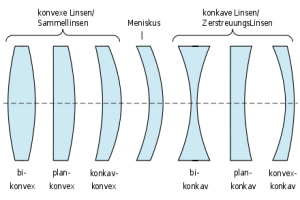Archives
Lens
The object points T0 an B0 are mapped to image points T1 and B1 by lens element number 1. The lens elements are numbered starting from object side.
The images T1 and B1 then become the new “object points” of lens element 2 and map T1 and B1 to “images of image” of T0 and T0, called T2 and B2″.
A lens with 10 lens elements accordingly generates sequences
T0->T1->T2->… -> T10
and
B0->B1->B2->….-> B10
It can be smaller or bigger than the object.
Image of microscopic details we of course want to be larger than the details.
lens equation
The “Gauss lens equation,” as it is known, goes like this:
where
f = focal length,
g = distance to object (measured from object side principal plane H).
b = distance to image (measured from image side principal plane H’).
It can be solved for focal length, object distance and image distance.
We may find the focal length by this equation:
We may find the object distance by this equation:
We may find the image distance by this equation:
Interpretation of the lens equation
What can be derived from this formula?
![]()
And therefore ![]()
(but subtract the distance of the principal points from X)
As a result, the object distance differs from the working distance in most cases.
Lens Types
lensmaker formula
The formula (at the bottom of this post) shows for thin, spherical lenses the relationship between shape and power.
Be d center thickness of the lens element.
![]() and
and ![]() be the radii of the spheres that describe the surfaces.
be the radii of the spheres that describe the surfaces.
Keep the sign conventions for radii in mind, however!
![]() be the index of refraction of the medium outside the lens and
be the index of refraction of the medium outside the lens and
n be the index of refraction of the lens material.
f be the focallength of the lens and
D be it’s Power, ![]()
![]()
![]()
Lensmaker’s formula:
Light
Light that we can see (“visible light”, “VIS”) is a small part of a spectrum of a thing called “electromagnetic radiation”, distinguished by something we call “wavelength”.
As the wavelength varies in the visible spectrum, the light appearantly changes color from violet to red.
There are no actual boundaries between one range of wavelengths and another. So numbers associated with a certain range are only approximate.
If we explore the spectrum from long wavelengths to shorter wavelengths, we meet :
- “radio waves” : regular broadcast wavelengths are for example 500 meters long, but even longer radio waves exist
- “short waves” : (“Radar waves”, “Millimeter waves”)
- “infrared”
- “visible light”
- “ultraviolet light”
- soft x-rays
- x-rays
- hard x-rays
- gamma rays
LM
LM A = Load Macro file A
Lock Ring
Rings of M12x0.5 female thread to fix s-mount lenses using the principle of the counter nut.
Lock-Rings are available from stock at www.lensation.de
![Lens_and_wavefronts[1]](https://www.optowiki.info/wp-content/uploads/2013/06/Lens_and_wavefronts1.gif)


